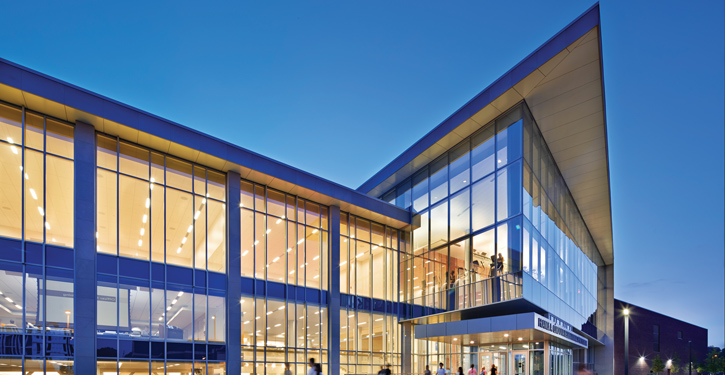What should you do with a well-used facility that’s clearly showing its age?
Start Big Picture
Set aside time to analyze the facilities across campus to catalogue what is being provided and where. Conduct a survey to learn if students are paying for something campus rec doesn’t offer, like trending name-brand group exercise classes. Work with a professional design team to perform a space-needs assessment based on enrollment and a space condition assessment to evaluate the condition and level of potential renovation of each rec space. It’s crucial to understand the biggest needs and highest priorities when navigating the countless decisions that arise during a renovation project.
Infuse Well-being
Hardly a trend but rather a way of life, identifying ways to infuse themes and tenets of well-being into students’ lives will set them up for success well beyond their college years. Spaces like underutilized racquetball courts can readily be renovated for a mind/body studio or stress-free zone. Older facilities, which often lack spaces for small social interactions, can be tailored to accommodate larger gatherings. Creating programming and physical space for mindfulness, nutrition, counseling, socializing and learning, such as financial awareness will pay dividends to your student body.
Partnership
Collaborate with campus and community partners. When properly equipped, an indoor climbing wall can be used for ROTC training. Coordinating handholds and the slope of a pool floor can facilitate hydrophysical therapy. These collaborations can maximize renovation expenses and generate possible revenue streams while benefiting a larger community.
A Double Take
When working through the planning and implementation process of a renovation project, consider the secondary use of spaces to incorporate and maintain flexibility in the future. For instance, a group exercise multi-purpose room can also be used as a classroom and meeting space when equipped with sufficient storage space and proper flooring. Spending the precious renovation dollars now to build in flexibility and multi-use function ultimately will bring more bang for your buck in the near future.
Building Systems
Don’t forget to assess the engineering systems of the building. No one notices the mechanical, electrical or plumbing systems until they aren’t working properly. For instance, are portable fans installed to mask an underlying heating, ventilation or air conditioning issue? Are light bulbs being replaced faster than you can say “energy hog” because the fixtures were installed 25-plus years ago? Are ceiling tiles discolored due to something above the ceiling that probably needs to be addressed? It’s important to remember these less glamorous systems are required for the building to actually operate, and since they may need to be repaired or brought up to current building and energy codes, the renovation budget must account for them as well.
Sustainability
Buildings account for 40% of global greenhouse gas emissions. Reusing an existing building and renovating systems are two of the most impactful ways to benefit the planet and carbon footprint.
No matter what scale of renovation is at play, expending the energy to approach the project holistically is the best approach to create a place where students want to be.
Sara Boyer is a principal, senior project architect with Moody Nolan. She can be reached at sboyer@moodynolan.com or visit moodynolan.com.










